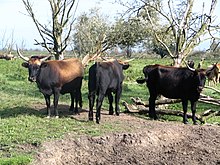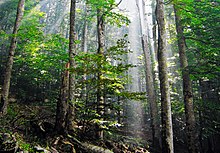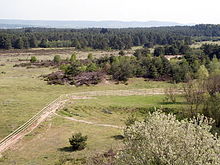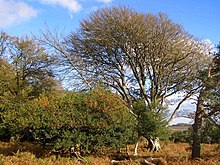Megaherbivore hypothesis


The megaherbivore hypothesis is a much discussed hypothesis from the fields of ecology and geobotany on the influence of large herbivores, the megaherbivores (from ancient Greek mega 'large', Latin herba 'herb' and vorare 'devour') on the vegetation and landscape structure, and the Conclusions that could possibly be drawn from this for today's vegetation and landscape.
The hypothesis assumes that large herbivores in natural population densities have a decisive influence on the vegetation and the landscape. Due to their influence on the vegetation, aurochs, bison, wild horses and deer would have prevented, for example, in the Holocene (geological epoch after the last glacial period ) in Central Europe, open landscapes were overgrown by dense forests and closed high forests formed; instead, semi-open, park-like pastures would have dominated. This influence was later exerted by farm animals that were herded into the woods to graze well beyond the Middle Ages . Similarly, African tree savannahs would be kept free from forests by large populations of grazing animals.
In addition, it is assumed that humans exterminated the largest megaherbivores ( elephants , rhinos ) in northern Eurasia at the end of the last ice age and kept the surviving animal populations low by hunting ( extermination hypothesis ). The same applies to comparable vegetation areas in North and South America and Australia. This led to the spread of relatively uniform plant communities that differed from those of the Pleistocene. In Africa, however, the original large animal fauna has been preserved ( living Pleistocene ) and has formed a diverse mosaic of grassland and tree populations over a large area.
The hypothesis is controversial and is presented inconsistently in details. Most researchers see the hypothesis as at least a fruitful research approach. The knowledge gained is put to practical use, especially when large grazing animals are used in the course of renaturation measures , so-called rewilding .
background
Definition of megaherbivores
As Megaherbivoren are large herbivores from the (over) trims the ungulates (Ungulata), mammoths (Proboscidea), also in America Edentata (especially the giant sloths ) denotes various extinct giant marsupials in Australia. The question of which species belong to the megaherbivores is not answered uniformly. For many authors, only gigantic grazing animals over 1,000 kg of body mass are megaherbivores (i.e. above all elephants and their extinct relatives, rhinos and the largest forms of the extinct American giant sloths and glyptodons ). Others include small to medium-sized mammals with a body mass of around 44 kg or more. Also in the mega herbivore hypothesis, animals such as cattle, horses and deer, all of which weigh less than 1000 kg, belong to the mega herbivores.
Vegetation history
The starting point of the hypothesis is the consideration of the Quaternary Age, a geological epoch that, depending on the definition, covers approximately the last two million years of geological history. During this entire age, the earth's climate was characterized by periodic fluctuations in which warm and cold periods alternated from tens to hundreds of thousands of years. During warmer periods of time, larger stands of trees could flourish in the temperate latitudes of Europe, while in the coldest phases, treeless mammoth steppes made of grass, herbs and dwarf shrubs shaped the landscape. The last glacial period began about 115,000 years ago when the Eem warm period ended. During the last warm period, forest elephants , forest rhinos , steppe rhinos , giant deer , aurochs and fallow deer lived in Europe as well as today's species, as well as water buffalo and hippopotamus in very warm phases . During the cold ages, they were replaced by woolly mammoths , woolly rhinos , musk oxen and reindeer . The large predators such as lions , leopards , hyenas and wolves appeared in both sections. The youngest still lasting section of the Quaternary is called the Holocene and, in climatic terms, corresponds to a warm period. This section began about 12,000 years ago when the last glacial period and with it the Pleistocene came to an end. At that time, the mammoth steppes in the middle latitudes, which were typical of the Cold Age, were first replaced by park landscapes, then by forests. As usual at the beginning of a warm period, the typical species of the mammoth steppe disappeared in the southern areas. In contrast to the earlier warm periods, however, they were not completely replaced by warm-period animals and died out a little later in their northern refuge areas. In addition, the large predators such as big cats and hyenas disappeared from large areas of the northern hemisphere. With the rewarming, trees spread further northwards. In contrast to the vegetation of the Pleistocene, which was dominated by mixed forms between open land and tree populations, the habitats of the Holocene, which correspond to today's natural landscapes, mostly represent relatively uniform zones that are dominated by individual plant types (forests, grasslands).

The reconstruction of Europe's vegetation history is primarily the result of pollen analyzes . Most of Central Europe was therefore since 9000 BC. BC mainly overgrown by birch and pine forests. From around 7000 to 6000 BC The country was covered by oaks, elms, linden, ash and maples from around 2000 BC. Chr. Increasingly dominated by beeches. Grass pollen has hardly existed since the end of the Pleistocene and has only reappeared in the recent past. Around 5000 BC Some areas were kept open by humans as agricultural areas. It is assumed that clearing and forest pasture management opened up the forests more and more, until at the latest when the Romans arrived at the turn of the century, they encountered semi-open cultural landscapes. Although this is broken through or surrounded by dense forests and moors, extensive open land areas are confirmed, for example, by the occurrence of the brown hare during this time. The intensification of human cultural activity led more and more to the decline of large-scale forests and to an enrichment of the landscape with small-scale structures and meadows and fields, as well as a multitude of forests, groups of trees and hedges and thus to an increase in biodiversity. The “ cultural landscapes ” of Central Europe from the 14th to 16th centuries and at the beginning of the 20th century are therefore often cited as an example. In some areas these landscapes were very rich in structure and offered a large number of open land species a new habitat.
History of the hypothesis
At the beginning of the 20th century it was assumed that a habitat that can be developed undisturbed would sooner or later be dominated by the largest and tallest plants that could potentially occur in the area. This type of vegetation is called climax vegetation . In most areas of Central Europe, dense high forests in various stages of succession ( mosaic cycle concept ) have dominated since the end of the Ice Age . According to this view, it was only the clearing of the forests for agriculture and grazing that led to the dense forests being broken up. Accordingly, dense, closed forests in Central Europe are usually viewed as a potential natural form of vegetation , while open land areas are generally considered to have been created by human influence. This view is challenged by the megaherbivore hypothesis, which assumes that large herbivores, which are not controlled by human hunting, have a decisive influence on their habitats. In its modern form, the megaherbivore hypothesis goes back mainly to Professor Vera, who formulated the thesis in Dutch in 1997 and later published it in English. Vera primarily refers to herbivores that were still common in the Holocene of Europe. However, the American biologist Paul S. Martin , who is considered to be the founder of the extinction hypothesis, assumed that the extinct megafauna of the Pleistocene could have strongly shaped the vegetation of their habitats. The extinction hypothesis assumes that humans are responsible for the disappearance of the Pleistocene megafauna. To this day, experts have disagreed as to whether this hypothesis is true. The megaherbivore hypothesis is closely related to the extinction hypothesis and is based in part on it.
Presentation of the hypothesis

The megaherbivore hypothesis assumes that the forests of Central Europe were kept open until agriculture was introduced by wild animals such as bison, aurochs, wild horses, red deer, elk and roe deer. This influence was later exercised by livestock, which until modern times were herded into the woods to graze in the woods. Similarly, the temperate forests of eastern North America were kept open by bison and deer until the arrival of Europeans.
A key point in the argument is the observation that pollen deposits from areas with grass and tree populations hardly show any grass pollen if they are heavily grazed by grazing animals. Accordingly, semi-open landscapes are difficult to distinguish from closed forests in pollen analyzes. The strong presence of the hazel in Central European forests up to around 3,000 years ago is a strong indication of semi-open landscapes, as the hazel does not usually bloom in closed forests. Furthermore, oaks are hardly able to regenerate naturally in closed forests. In open hat forests, oaks are even superior to other species such as the common beech. The frequent occurrence of oaks during long phases of the Holocene, especially 8,000–5,000 years ago, is therefore a further indication of semi-open natural forests as the original vegetation type before the introduction of agriculture around 5,000 years ago.
In addition, it is often assumed that humans contributed to their extinction during the late Pleistocene by hunting large herbivores. These species can be counted as part of the natural fauna. Numerous large herbivores disappeared during the Great Quaternary Extinction . In Europe, for example, the mammoth and woolly rhinoceros died out around 12,000 years ago. Species that lived in Central Europe during the last warm period , which ended around 115,000 years ago, also died out in their retreats in the Mediterranean region in the late Pleistocene; these include the European forest elephant and forest rhinoceros. According to the megaherbivore hypothesis, humans are also responsible for their extinction.
According to the proponents of the hypothesis, increasing hunting pressure from humans could have resulted in relatively low populations of surviving grazing animals such as wild cattle, horses and deer during the late Pleistocene. Only the reduction in the number of species and populations of large herbivores after global warming at the beginning of the Holocene made it possible for dense forests to spread across the board.
In some areas of America and Australia, increased growth on trees was found after some herbivores became extinct. After the last ice age, a dense forest cover (repopulation) could have started in Central Europe, since the herbivores had become too little to have a significant impact on the vegetation. This climax of succession , which emerges in Central Europe, resulted mainly in beech forests , beech and other mixed forests , coniferous forests and azonal and extrazonal forest communities .
A strong argument for the mega herbivore hypothesis results from the consideration of the deciduous forests of the North American east coast . Here, the oak genus, which is represented here in a very diverse range of species, is described as the dominant genus of the "pre-settlement forests", i.e. the primeval forests that grew before the colonization by the Europeans. These forests are considered to have arisen without being influenced by humans. In addition to oak, hickory is also strongly represented in these forests . However, these oak-hickory forest communities hardly rejuvenate; they are often replaced by shade-tolerant species such as red maple . At the moment neither oaks such as the white oak nor the hickorys are rejuvenating in these forests, although the oaks always have a high proportion in American pollen diagrams of the warm periods. At the same time, the bison , the last remaining mega herbivore in North America, was only recently eradicated in these areas.
Influence of megaherbivores on vegetation
Early observations on the influence of grazing cattle on originally closed forests date from the time of the early medieval forest protection , which can contribute to a very significant change in the landscape within a few decades, i.e. within a human lifetime . Around settlements, cattle such as cattle, pigs, sheep, etc. grazing in the forest created an initially thinned forest without small vegetation and undergrowth, which was increasingly made up of a few large, aging trees with spreading crowns (decreasing competitive pressure) and soon numerous meadow plants typical of open landscapes was carried. With the death of the larger trees, the forest finally disappeared completely, making the area available for arable farming without having to be cleared. The manner in which the landscape is transformed, the speed and shape of the end result, however, depend on numerous factors such as the intensity of grazing, species of animals, temporal continuity and the like. a. from. Grazing with sheep quickly leads to the disappearance of all regrowing seedlings, while horses also bite larger trees and influence their growth habit. During the colonial period it was recognized that this effect can be observed in landscapes and growth forms of trees all over the world.
It is therefore assumed that the prehistoric flora and vegetation were also significantly influenced by the herbivores living at the time. Since the vegetation can also cause geological changes such as erosion, resistance to exogenous forces and sedimentation, megaherbivores are also discussed as geologically relevant influencing factors. However, very long periods of time and long-term effects must be taken into account here.

According to the megaherbivore hypothesis, it is likely that, without human influence, a mosaic of areas in different stages of succession would prevail in large parts of Europe . The browsing of large herbivores (megaherbivores) would not only create forests, but also more or less open meadow landscapes. A herd behavior, derived from the behavior of recent species , is assumed, which by wandering around creates locally strongly differentiated influences on the vegetation. Food preferences (preference for certain plants) differ depending on the animal species and overlay social behavior. The location plays a decisive role, so the natural forest community ( see potential natural vegetation ) is not equally resistant to browsing everywhere. Thorn bushes are also assigned a decisive role by proponents of the hypothesis in areas influenced by grazing, as they establish themselves in these areas and, through their thorn protection for herbivores, could form impenetrable thickets, which then also protect other, thornless bushes such as hazel , but also trees how the oak could grow up. In Europe, the sloe in particular is given a prominent position due to its root brood , as a single "mother shrub" could cover large areas over the years and subsequently create entire groves . The hypothesis is based on the assumption that the shrubs themselves die off as the trees growing out of them cast shadows and would thus again provide grazing space for the herbivores, thus closing the circle.
According to the theory, high forest is to be expected more on nutrient-poor soils, since the plants growing there are more difficult to digest and also have defense strategies. A wooded and heterogeneous landscape could have emerged in such areas. If young growth is frequently eaten away, the forest thins out without the regrowing trees being able to replace the dying ones; an open landscape is created. Steps could also have been created in places that animals prefer to visit, for example on bodies of water. Spacious, semi-open landscapes could have prevailed where herbaceous vegetation that is rich in protein and nutrients grows better on nutrient-rich and fresh soils. These areas could have been visited periodically, so that relatively homogeneous parts of the landscape are considered likely. Other factors are added: fattening years , epidemics, pests, droughts and wet years, migration / territorial behavior of predators , wilderness and forest fires, overgrazing , so that a very clear differentiation could have arisen.
However, the influence of herbivores through their population regulation through predators , diseases, parasites and, last but not least, through lack of forage in winter never became so great that the forest could be completely pushed back. In some areas (e.g. Serengeti) living (recent) herbivores regulate themselves exclusively through the food supply in dry seasons and the water supply. For Central Europe, hard winters with their food shortages and predators are more in the foreground. On the basis of the comparison with known cultural or natural landscapes , which are considered to be similar, a greater diversity of species is assumed in such a landscape, also characterized by herbivores.
criticism
The fact that there are species that are dependent on undisturbed forest development over centuries speaks against the mega-herbivore hypothesis. In Central Europe, in contrast to the Mediterranean region or the steppe landscapes of the east, there are virtually no endemic plant species and subspecies of the open land, which indicates a relatively young age of the open vegetation. However, opposing views also exist on this objection. Another argument that seems to speak against the hypothesis is the fact that pollen research does not reveal any evidence of open landscapes after the end of the last glacial period (cf. e.g. and). In the Holocene, pollen from open land species (such as grasses) did not appear more frequently until the beginning of the Neolithic (with the introduction of arable farming and cattle breeding in Central Europe). This indicates that since the disappearance of the mammoth steppes initially dense forests dominated. However, this argument, which seems powerful at first glance, has been put into perspective by another side. Paradoxically, pollen samples from mixed grassland-forest landscapes sometimes resemble those from dense wooded areas as soon as cattle graze there all year round. The grasses are then obviously heavily grazed and rarely bloom, which is why the tree pollen also dominates the open grass areas. This would mean that open land areas interspersed with trees and at the same time heavily grazed by large animals can hardly be distinguished from closed forests in the pollen diagram. Another point of criticism relates to some arguments based on comparisons with other open habitats, in which numerous large herbivores still occur today. Thus, East and South African ecosystems can presumably only be compared to central European ecosystems to a limited extent.
It cannot be clearly proven whether the assumed conditions really apply. B. the paleobotany give only incomplete information about the size of the mosaics and thus the spatial distribution. Also about the social behavior of animal species and their population sizes there are only deductions from those of related species living today. Finally, assumptions are made about the causes of the extinction of the animal species. The claim that humans have made a significant contribution to this has so far been unproven. So could z. For example, it can be shown that the giant deer ( Megalocerus giganteus ) died out in Ireland a few hundred years before human immigration, probably due to changes in vegetation as a result of climate change. There are similar doubts about the extinction hypothesis of the Pleistocene megafauna for many other species. On the other hand, however, the extinction of the megafauna, both continentally and in Australia, New Zealand or Madagascar, coincided several times with the first colonization by anatomically modern humans.
Practical reference to the hypothesis

The hypothesis has found great interest beyond paleoecology and paleontology in the fields of ecology and geobotany . This is due to the implications for vegetation and landscape change. If the hypothesis is correct, the primeval forests of Central Europe before the Neolithic would not be the “real” primeval nature of Central Europe, but “only” go back to human influence (the Stone Age hunters). If the landscape is later opened or kept open by humans and their grazing cattle, that would only restore the actual natural state. The grazing animals would therefore be the ecological substitute for the extinct megaherbivores. The hypothesis was therefore particularly popular with conservationists who work with grazing animals to maintain the landscape . For example, this theory can be used to explain why both typical pasture and meadow plants as well as typical forest plants occurred at the same time in Central European areas, which are assumed to have been before the onset of human cultural activity (except for moors, bodies of water and High mountains) were covered by contiguous forests. If animals are used to maintain the landscape that have colonized the respective area in the Pleistocene, one speaks of Pleistocene Rewilding .
There are therefore practical applications of this theory, for example, for nature conservation , where the requirement is often derived that landscapes rich in structures and species, which are no longer farmed, should be preserved in grazing projects with the help of herbivores.
See also
Web links
- “Quaternary Park - Thoughts on Forest, People and Megafauna” by Bunzel-Drüke, M., Drüke, J. & H. Vierhaus (1994). ABUinfo 17/18, issue 4/93, 1/94. The first publication on the mega herbivore theory
- Primeval forests were not primeval parks. On: Wissenschaft.de of January 13, 2005. Grazing animals had no influence on the dense tree population of primeval forests.
Individual evidence
- ↑ a more recent overview in CN Johnson: Ecological consequences of Late Quaternary extinctions of megafauna (PDF; 306 kB) . In: Proceedings of the Royal Society. Series B 276, 2009, pp. 2509-2519.
- ^ A b Norman Owen-Smith: Pleistocene Extinctions: The Pivotal Role of Megaherbivores. Paleobiology, 13 (1987), pp. 351-362.
- ↑ a b M. Bunzel-Drüke, J. Drüke, H. Vierhaus: Quaternary Park - reflections on forest, man and megafauna. (1994). ABUinfo 17/18, issue 4/93, 1/94. (on-line)
- ↑ a b c d F. WM Vera: Grazing ecology and forest history. CABI Publishing, Wallingford / New York, ISBN 0-85199-442-3 .
- ^ Paul S. Martin, Richard G. Klein: Quaternary Extinctions: A Prehistoric Revolution. Arizona University Press 2004. ISBN 0-8165-0812-7 .
- ↑ Donald K. Grayson, David J. Meltzer : A requiem for North American overkill. Journal of Archaeological Science 30 (2003): pp. 585-593.
- ↑ (PDF) Grazing Ecology and Forest History. Retrieved September 21, 2019 .
- ^ Pott, Richard & Hüppe, Joachim: The Hudelandschaften Northwest Germany. Treatises from the Westfälisches Museum für Naturkunde Münster 53. ISBN 3-924590-27-3 .
- ↑ Helge Walentowski, Andreas Zehm: Relictic and endemic vascular plants in the wooded region of Bavaria - a vegetation-historical analysis to focus on botanical species protection . Tuexenia 30: 59-81. Göttingen 2010
- ^ H. John B. Birks: Mind the gap: how open were European primeval forests? Trends in Ecology & Evolution 20 (4) 2005: pp. 154–156.
- ^ Litt, Thomas: Waldland Mitteleuropa. The mega herbivore theory from a paleobotanical point of view. In: Large animals as landscapers. LWF report 27 (2000). Published by the Bavarian State Institute for Forests and Forestry.
- ↑ Anthony D. Barnosky : "Big game" extinction Caused by Late Pleistocene climatic change: Irish elk ( Megaloceros giganteus ) in Ireland. Quaternary Research 25 (1986): 128-135.



